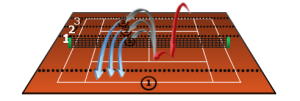Where to find them: Continental Europe, South America
Though you can find plenty of clay courts in the United States, they are more often than not controlled by clubs that require a membership or heavy court fees. Clay courts are more often found in Europe or South America. The Spaniard, Rafael Nadal, who grew up playing on clay, shows how to perfect the clay court game. It is the softest surface out there and therefore quite forgiving and easy to play on, especially for beginners. Often it is easier to build your game on clay first, because it requires you to use the court more effectively, construct points, and be mobile.
Transitioning from a clay court to a hard courts, as opposed to the other way around, is preferred. Since clay is slower than other courts, it isn’t always easy to hit winners. Rather players must combine shots to get an opponent in a defensive position. You can also slide to the ball on the loose clay court players which enables you to cover more of the court with the proper movement. At the same time, changing directions isn’t as easy on clay because of this slick surface. Though this slow surface allows a player more time to hit the ball, don’t be surprised if you get some bad bounces.
What is my strategy on this surface?
– Focus on consistency in play
As already explained, clay reduces the speed of your shots and makes it easier for your opponent to reach the ball. Rallies can last a long time, often hitting the ball back and forth upwards of 20 times. That is why you should not focus on hitting the perfect winner, but keeping the ball in the game and in turn not losing yourself the point.
Drill: The court is split into three areas that are each allocated with a number (1, 2 and 3). The coach calls upon Player 1 to hit the balls into the areas right before the ball touches the ground. Player 2, on the other side of the court, tries to hit every ball to the back half of the court (as close to the baseline as possible). After about 10 minutes, players exchange roles so that each of them trains consistently in playing balls close to the baseline.
– Topspin Balls
Being consistent means staying physically and mentally in the game. Instead of just hitting aggressive strokes, focus on hitting the ball with more topspin as it is a great shot for high bounces and supporting long rallies.
Drill: String a rope 3 to 6 feet above the net. While playing with your partner, try to consistently hit topspin shots into back half of the court. Focus on hitting the ball 5 to 10 times above the rope and then – if your opponent hits a shorter shot – try to attack by hitting a winner either crosscourt or down the line.
– Hitting the right angles
The chance of closing the point with a quick rally is quite low which means you have to steadily keep moving, and getting your opponent to move, in order to win a point. You don’t necessarily need to paint the line, but you must take advantage of the whole court by hitting precise angles that keeps your opponent on the run.
Drill: Place marks where the service line crosses the side line. While playing a rally Player 1 and 2 try to play shots with an angle to place the ball close to the marks on the opponent’s side of the court. By doing so, both players can earn points when they hit the marks or the marked area. (*graphic depicts after a rally)
– Take a chance at the net
As soon as you put your opponent in a defensive position by either hitting a long topspin ball or creating a great angle, approach the net to finish up the point. Usually, your opponent won’t be able to return an aggressive or winning shot.
Drill: Work with the previous drill and approach the net after your opponent hits a shorter ball and you attacked him with a crosscourt or down the line shot. (*graphic depicts after a rally)




